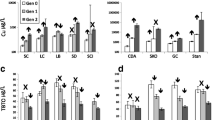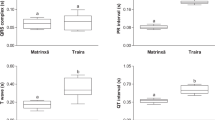Abstract
Exposure to sub-lethal concentrations of a pollutant induces, in some organisms, an acclimation process which increases their resistance to other substances (cross-acclimation). Understanding this phenomenon is important as a basis for a better comprehension of the effects of pollutants in ecosystems. In this paper we investigated whether the exposure to Cd or Zn is able to modify the heart rate response of the crayfish Procambarus clarkii to acute Cu stress. A first set of experiments provided the basis to understand heart rate changes induced by varying Cd or Zn concentrations. In a second set of experiments crayfish were acclimated for 96 h to control water, Cd or Zn enriched water, and then exposed to a 10 mg L−1 Cu solution, known to induce bradycardia in this species. Bradycardia was suppressed in specimens previously exposed to Cd or Zn but not in those exposed to clean water, providing a clear evidence of a cross-acclimation in the heart rate response of P. clarkii.


Similar content being viewed by others
References
Alcorlo P, Otero M, Crehuet A, Baltanas A, Montes C (2006) The use of the red swamp crayfish (Procambarus clarkii, Girard) as indicator of the bioavailability of heavy metals in environmental monitoring in the River Guadiamar (SW, Spain). Sci Total Environ 366:380–390
Amiard J-C, Amiard-Triquet C, Barka S, Pellerin J, Rainbow PS (2006) Metallothioneins in aquatic invertebrates: their role in metal detoxification and their use as biomarkers. Aquat Toxicol 76:160–202
Bamber SD, Depledge MH (1997) Responses of shore crabs to physiological challenges following exposure to selected environmental contaminants. Aquat Toxicol 40:79–92
Bini G (2006) Cardiac responses of marine and freshwater invertebrates induced by natural and anthropogenic stresses: potentials for their use as biomarkers of metal pollution in aquatic environments. PhD Thesis, University of Florence (in Italian)
Bini G, Chelazzi G (2006) Acclimatable cardiac and ventilatory responses to copper in the freshwater crayfish Procambarus clarkii. Comp Biochem Physiol A 144:235–241
Bini G, Castellano E, Udisti R, Santini G, Chelazzi G (2008) Intra-specific variation in cardiac activity of the Mediterranean limpet Patella caerulea along a contamination gradient. Ethol Ecol Evol 20:271–281
Blackmore G, Wang WX (2002) Uptake and efflux of Cd and Zn by the green mussel Perna viridis after metal preexposure. Environ Sci Technol 36:989–995
Brinkman SF, Johnston WD (2012) Acute toxicity of zinc to several aquatic species native to the Rocky Mountains. Arch Environ Contam Toxicol 62:272–281
Brown RJ, Galloway TS, Lowe D, Browne MA, Dissanayake A, Jones MB, Depledge MH (2004) Differential sensitivity of three marine invertebrates to copper assessed using multiple biomarkers. Aquat Toxicol 66:267–278
Camus L, Davies PE, Spicer JI, Jones MB (2004) Temperature-dependent physiological response of Carcinus maenas exposed to copper. Mar Environ Res 58:781–785
Chelazzi G, De Pirro M, Williams GA (2004) Different cardiac response to copper in limpets from metal polluted and clean shores of Hong Kong. Mar Environ Res 58:83–93
Coile P, Philcox JC, Carey LC, Rofe AM (2002) Metallothionein: the multipurpose protein. Cell Mol Life Sci 59:627–647
Cosper EM, Snyder BJ, Arnold LM, Zaikowski LA, Wurster CF (1987) Induced resistance to polychlorinated biphenyls confers cross-resistance and altered environmental fitness in a marine diatom. Mar Environ Res 23:207–222
De Pirro M, Cannicci S, Santini G (1999) A multi-factorial experiment on heart rate variations in the intertidal crab Pachygrapsus marmoratus. Mar Biol 135:341–345
Del Ramo J, Torreblanca A, Martinez M, Pastor A, Diaz-Mayans J (1995) Quantification of cadmium-induced metallothionein in crustaceans by the silver-saturation method. Mar Environ Res 39:121–125
Farwell M, Drouillard KG, Heath DD, Pitcher TE (2012) Acclimation of life-history traits to experimental changes in environmental contaminant concentrations in brown bullhead (Ameiurus nebulosus). Environ Toxicol Chem 31:863–869
Gall ML, Holmes SP, Dafforn KA, Johnston EL (2013) Differential tolerance to copper, but no evidence of population-level genetic differences in a widely-dispersing native barnacle. Ecotoxicol 22:929–937
Gautam RK, Sharma SK, Mahiya S, Chattopadhyaya MC (2014) Contamination of heavy metals in aquatic media: transport, toxicity and technologies for remediation. In: Sharma SK (ed) Heavy metals in water: presence, removal and safety. The Royal Society of Chemistry, Cambridge, pp 1–24
Gherardi F (2006) Crayfish invading Europe: the case study of Procambarus clarkii. Mar Freshw Behav Physiol 39:175–191
Hebel D, Jones MB, Depledge MH (1997) Responses of crustaceans to contaminant exposure: a holistic approach. Estuar Coast Shelf Sci 44:117–184
Henriques JF, Tavares PC, Correia-dos-Santos MM, Trancoso MA, Santos-Reis M, Branquinho C (2014) Monitoring Hg and Cd contamination using red swamp crayfish (Procambarus clarkii): implications for wetland food chain contamination. Water Air Soil Pollut 225:2210
Ketpadung R, Tangkrock-olan N (2006) Changes in oxygen consumption and heart rate of the blue swimming crab, Portunus pelagicus (Linnaeus, 1766) following exposure to sublethal concentrations of copper. J Environ Biol 27:7–12
Klerks PL, Weis JS (1987) Genetic adaptation to heavy metals in aquatic organisms: a review. Environ Pollut 45:173–205
Kouba A, Buřič M, Kozák P (2010) Bioaccumulation and effects of heavy metals in crayfish: a review. Water Air Soil Pollut 211:5–16
Lundebye AK, Depledge MH (1998) Automated interpulse duration assessment (AIDA) in the shore crab Carcinus maenas in response to copper exposure. Mar Biol 130:613–620
Luoma SN, Rainbow PS (2008) Metal contamination in aquatic environments: science and lateral management. Cambridge University Press, Cambridge
Mali RP, Afsar S (2011) Effect of Zinc Sulphate on Cardiac Physiology of the crab Barytelphusa guerini. Nat Environ Poll Technol 10:489–490
Martin-Diaz ML, Tuberty SR, McKenney CL, Sales D, Del Valls TA (2005) Effects of cadmium and zinc on Procambarus clarkii: simulation of the Aznalcollar mining spill. Cienc Mar 31:197–202
Martin-Diaz ML, Tuberty SR, Mckenney CL, Blasco J, Sarasquete C, Delvalls TA (2006) The use of bioaccumulation, biomarkers and histopathology diseases in Procambarus clarkii to establish bioavailability of Cd and Zn after a mining spill. Environ Monit Assess 116:169–184
Martinez M, Torreblanca A, Del Ramo J, Pastor A, Diazmayans J (1993) Cadmium-induced metallothionein in hepatopancreas of Procambarus clarkii – quantification by a silver-saturation method. Comp Biochem Physiol C 105:263–267
McGeer JC, Nadella S, Alsop DH, Hollis L, Taylor LN, McDonald DG, Wood CM (2007) Influence of acclimation and cross-acclimation of metals on acute Cd toxicity and Cd uptake and distribution in rainbow trout (Oncorhynchus mykiss). Aquat Toxicol 84:190–197
More A (2011) Sub-lethal effects of copper sulphate, zinc sulphate and cadmium sulphate on rate of heart beat of fresh water crab Barytelphusa guerini. Ann Biol Res 2:437–440
Morgan AJ, Kille P, Stürzenbaum SR (2007) Microevolution and ecotoxicology of metals in invertebrates. Environ Sci Technol 41:1085–1096
Mouneyrac C, Mastain O, Amiard JC, Amiard-Triquet C, Beaunier P, Jeantet AY, Smith BD, Rainbow PS (2003) Trace-metal detoxification and tolerance of the estuarine worm Hediste diversicolor chronically exposed in their environment. Mar Biol 143:731–744
Muyssen BTA, Janssen CR (2002) Tolerance and acclimation to zinc of Ceriodaphnia dubia. Environ Pollt 117:301–306
Naito W, Kamo M, Tsushima K, Iwasaki Y (2010) Exposure and risk assessment of zinc in Japanese surface waters. Sci Total Environ 408:4271–4284
Peña MMO, Jaekwon L, Thiele DJ (1999) A delicate balance: homeostatic control of copper uptake and distribution. J Nutr 129:1251–1260
Qu RJ, Wang XH, Feng MB, Li Y, Liu HX, Wang LS, Wang ZY (2013) The toxicity of cadmium to three aquatic organisms (Photobacterium phosphoreum, Daphnia magna and Carassius auratus) under different pH levels. Ecotoxicol Environ Saf 95:83–90
Rainbow PS, Ng TYT, Shi DL, Wang WX (2004) Acute dietary preexposure and trace metal bioavailability to the barnacle Balanus amphitrite. J Exp Mar Biol Ecol 311:315–337
Silvestre F, Dierick JF, Dumont V, Dieu M, Raes M, Devos P (2006) Differential protein expression profiles in anterior gills of Eriocheir sinensis during acclimation to cadmium. Aquat Toxicol 76:46–58
Suárez-Serrano A, Alcaraz C, Ibáñez C, Trobajo R, Barata C (2010) Procambarus clarkii as bioindicator of heavy metal pollution sources in the lower Ebro river and delta. Ecotoxicol Environ Saf 73:280–286
Sun PY, Foley HB, Handschumacher L, Suzuki A, Karamanukyan T, Edmands S (2014) Acclimation and adaptation to common marine pollutants in the copepod Tigriopus californicus. Chemosphere 112:465–471
Truchot JP, Rtal A (1998) Effects of long-term sub-lethal exposure to copper on subsequent uptake and distribution of metal in the shore crab Carcinus maenas. J Crustac Biol 18:224–231
Underwood AJ (1996) Experiments in ecology, their logical design and interpretation using analysis of variance. Cambridge University Press, Cambridge
Wang WX, Rainbow PS (2005) Influence of metal exposure history on trace metal uptake and accumulation by marine invertebrates. Ecotoxicol Environ Saf 61:145–159
Wang D, Xing X (2009) Pre-treatment with mild metal exposure suppresses the neurotoxicity on locomotion behavior induced by the subsequent severe metal exposure in Caenorhabditis elegans. Environ Toxicol Pharmacol 28:459–464
West-Eberhard MJ (1989) Phenotypic plasticity and the origins of diversity. Annu Rev Ecol Syst 20:249–278
Williams KA, Green WJ, Pascoe D (1985) Studies on the acute toxicity of pollutants to freshwater macroinvertebrates. 1. Cadmium. Arch Hydrobiol 102:461–471
Wright DA, Welbourn PM (1994) Cadmium in the aquatic environment: a review of ecological, physiological, and toxicological effects on biota. Environ Rev 2:187–214
Acknowledgments
The study was supported by a grant from the University of Florence to GC. Comments from two referees and Senior Editor greatly improved the manuscript.
Conflict of interest
The authors declare that they have no conflict of interest.
Ethical standard
All applicable national guidelines for the care and use of animals were followed.
Author information
Authors and Affiliations
Corresponding author
Rights and permissions
About this article
Cite this article
Bini, G., Santini, G. & Chelazzi, G. Pre-exposure to Cadmium or Zinc Alters the Heart Rate Response of the Crayfish Procambarus clarkii Towards Copper. Bull Environ Contam Toxicol 95, 12–17 (2015). https://doi.org/10.1007/s00128-015-1535-3
Received:
Accepted:
Published:
Issue Date:
DOI: https://doi.org/10.1007/s00128-015-1535-3




